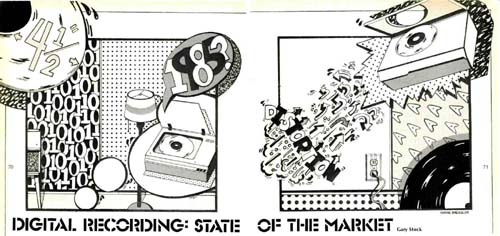
by Gary Stock
Allow me to prophesy an event in your future, if I may be so presumptuous. If you are genuinely interested in the reproduction of music, and living in any population center larger than 500 people, there will be a very special and unquestionably memorable day in your life in the next few years. Some time between now and 1985, you will walk into an audio salon and ask to hear a digital audio disc system. The salesman will oblige; he will show you a disc player that may be as small as a cigar box or as large as a transcription turntable. In it, or perhaps on it, he will place a disc. The disc will probably be either an odd matte black or a rainbow-splashed opalescent silver. It may be as small as 4 1/2 in. or as large as 12.
Those details are not important, except to those who have designed the equipment.
What is important is that this first audition of a digital disc system will change forever your perception of the home music system's capacity to recreate reality. It will transport you to a new world of sonic excellence and demonstrate an immediacy, vibrance, and aliveness that no conventional long-playing record could ever truly match. By comparison with the vivid, sharply defined tonal colors of the digital disc, even the direct-to-disc and digitally mastered LP records, which have recently set the recording industry on its ear, will seem slightly pallid and drawn.
I have not sold my soul to Mephistopheles in exchange for the gift of prescience. I'm able to predict this sort of event with a fair amount of confidence because I've seen the products in question--the players, the discs--and heard the superb sound quality they produce. These devices exist now.
The units the press has heard are prototypes, but all are technical faits accompli. Only the decision to initiate their manufacture stands between them and the showroom shelf.
PCM Basic Theory
The extraordinary sound quality of the digital disc players is a result of their use of the pulse code modulation (PCM) encoding system, an information storage method in which musical signals are handled and stored in the form of long groups of numbers. In a PCM device, such as a digital tape recorder or a digital disc system, the conventional audio signal has been converted into a string of binary num bers-"0"s and "1"s, as it were. This is done by sampling the musical wave form at frequent intervals (usually in the range of 40,000 to 55,000 times per second), measuring the level of each of these samples, converting that level to a binary number--the "0"s and "1"s, and storing that number as pulses and silent spaces on tape or in directly on the surface of a disc. In order to reconstruct the original music, therefore, one need only be able to distinguish between pulses and silent spots, and know how frequently the original signal was sampled (the sampling rate). This rate is controlled by a highly accurate electronic "clock" in both the recording and playback phases, so small variations in, say, the digital recorder's transport mechanism or the disc player's platter speed have no effect on the precise rate at which the tape or disc's digital signal is reassembled into a conventional analog out put, and therefore have no effect on the music. The musical signal is also immune to most other sources of incidental noise and distortion in the re cording and playback chain, since only pulses and silent sections of fixed amplitude are being stored and recalled.
The wow-and-flutter specifications of the prototype digital disc systems are therefore immeasurably low, and the theoretical distortion, dynamic range, and bandwidth specifications significantly better than could be achieved by any analog method.
A short list of the requirements for a practical digital disc is a sobering document to contemplate, however. In order to fall within the price range necessary to ensure accessibility to the general public, the disc cannot cost very much more than a conventional LP record. It must be able to be mastered and manufactured at high speed and be fabricated of an inexpensive material. It must be durable, resistant to our increasingly noxious atmosphere, and fairly simple to use and to store. A little basic arithmetic tells us that with 50,000 binary numbers per second of playing time, an hour of recorded music will require the disc to store some 180 million separate groups of numbers, an information density far higher than that of a conventional record.
Surprisingly, despite these stringent requirements, three separate methods of putting a PCM-encoded signal on a disc (and getting it off again) have been developed. All meet the basic criteria we have set, in their own individual ways. They are:
The Mechanical Approach: Visc-o-Pac
Matsushita, parent company of Panasonic, has developed the player system closest in principle to the classic stylus and groove of the phono graph record. Their Visc-o-Pac system uses a minute diamond stylus tip, bonded directly to a piezo-ceramic "chip," to play an extremely narrow groove in a 9-in. vinyl disc. The groove is vertically modulated, i.e. it has hills and valleys over which the stylus rides.
Tracking these grooves with a stylus force of only a few milligrams, the stylus transmits variations in pressure caused by the pattern of hills and dales to the piezo-electric element, which generates an output voltage proportional to the vertical modulation of the groove. The hills and valleys, in effect, represent the "0"s and "1's of our binary number groups.
Visc-o-Pac is much more complex than any conventional turntable, de spite its straightforward theory of operation. Its "tonearm," if it can be called that, tracks radially from the innermost grooves outward, moving at a constant velocity. The arm is driven by a servomechanism, since no free-pi voting arm could track such a narrow, shallow groove at such low pressures unassisted. The disc revolves at a speed varying from 300 to 700 rpm, de pending on the position of the stylus, the objective being to maintain a constant relative speed even though the radius being touched by the stylus changes.
The disc itself is enclosed in a two sided plastic case that is automatically removed from the surface to be played when the disc is put in the player. It has a playing time of two hours (one hour per side), and a life of at least 1,000 plays. The stylus assembly, like the stylus of a normal phono cartridge, is replaced by the user at intervals of 1,000 hours or so. Much of the Visc-o Pac technology is derived from Matsushita's efforts in the consumer videodisc field. In fact, the Visc-o-Pac player is primarily intended for video disc playback, with digital audio to be a secondary function. Matsushita has committed to this simple system, one reliant upon proven technology, in an effort to keep the price of the basic player within the reach of the non-audiophile videodisc customer. A retail price under $500.00, with discs costing about 50 percent more than contemporary LPs, is projected by company spokesmen. The projected price of the PCM adaptor is $250.00.
The Capacitive Approach: VHD/AHD
As its name suggests, JVC's proto type Video High Density/Audio High Density (VHD/AHD) digital disc player is fundamentally a videodisc player that may be equipped, via an out board PCM adaptor, to play audio-only discs. VHD/AHD uses a stylus (of sorts) in contact with the surface of a 12-in. disc, but the stylus is used as an electrode, rather than a mechanical sensing element. The broad pentagonal "footprint" of the stylus tracks along rows of wide, oval-shaped depressions called "signal pits" that are molded into the disc surface; the arm is guided by servomechanisms that monitor the stylus' position using dual rows of slender tracking pits that run at right angles to the signal pits.
The JVC disc is made of a vinyl-based plastic that is electrically conductive.
The electrode/stylus moving over the surface of the disc acts as one plate of a capacitor, the disc surface itself as the other plate. The pits therefore continuously modulate this capacitance, causing a carrier tone to be frequency modulated. Once demodulated, this modulation signal comprises the digital information that contains the music. Due to the broad stylus "footprint," VHD/AHD discs have a lifespan of at least 54,000 plays; stylus life is 2,000 hours or so. The discs turn at 900 rpm and have a playing time of two hours, one hour per side. They are enclosed in a dust-tight sleeve. Sliding the sleeve into the player's front panel extracts the disc for play; inserting it again removes the disc.
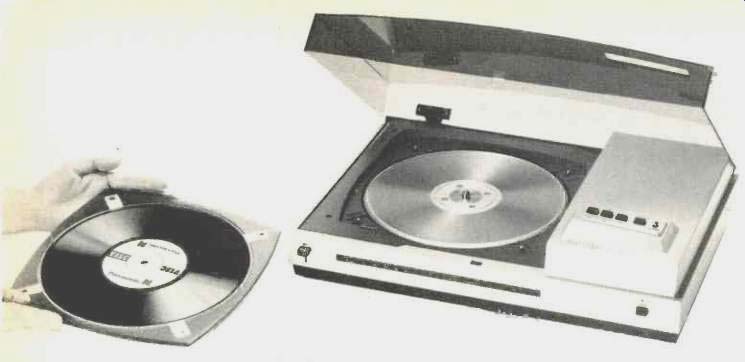
Fig. 1-Matsushita/ Panasonic Visc-o-Pac player and discs.
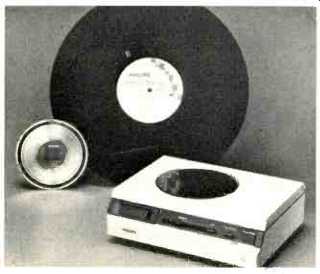
Fig. 3-Philips Compact-Disc player.

Fig. 2-JVC Video High Density/Audio High Density player.
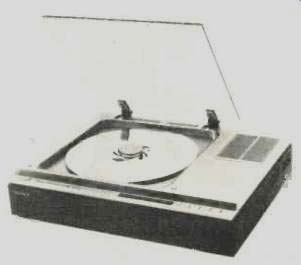
Fig. 4-Sony DAD-1X player.
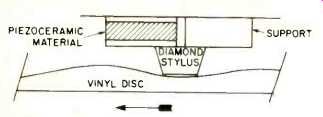
Fig. 5-Visc-o-Pac stylus assembly and disc surface. The stylus reacts to vertical
modulation of the record-surface, applying pressure to piezo ceramic element.
Support member acts as a fulcrum.

Fig. 6.-JVC VHD/AHD stylus and disc surface. Note the wide signal pits and
long, slender tracking pits.
JVC also endeavors to offer their basic player at a moderate price--per haps under $600.00, although the optional PCM adaptor will add consider ably to that sum. Other options include a random access unit for rapid access to any point on the disc and a video-oriented "Trick-play Unit" for such picture special effects as stop-frame and slow motion.
The Optical Approach: Compact Disc and DAD-1X
The third and most complex approach to storage of PCM information in disc form is the laser-read optical system, represented here by two prototype players--the Philips Compact Disc and the Sony DAD-1X--whose operating characteristics have been described publicly in some detail.
The Compact Disc is by far the smallest of the digital disc players demonstrated thus far. The dimensions of the player are approximately 10x7x3 ins., about the size of a portable cassette recorder (the dimensions have not been formally released; what I've indicated is derived from my examination of the unit at its demonstration). The discs are a brilliant silver, and only 4 1/2-in. in diameter, smaller than a doughnut 45-rpm record.

Fig. 7--Visc-o-Pac protective cover. Cover is automatically removed after
insertion into player.
The Compact Disc's scanning element is a byproduct of Philips' video disc research. It is a miniature, low-power laser element that reads the disc radially from below, the laser moving from inner radius to outer. The focus and lateral position of the laser are maintained by multiple servo mechanisms. The beam of the laser is focused in a tiny spot on the disc's reflective, aluminum-plated center layer, which is impressed with a spiral track composed of millions of tiny pits.
The light beam from the laser is reflected by the aluminum surface and its brightness continuously modulated by the pattern of the pits. This reflected light beam passes through a series of mirrors and prisms to a photodiode that converts the light into a modulated electrical signal, which in turn is decoded into the PCM audio signal, as well as tracking information to control the laser elements' servomechanisms and program-indexing information that can be displayed on the front panel as letters or numbers on an alphanumeric display. In the Philips system, a black space on the disc represents a binary "0," while a pit represents a binary "1." I here is no physical contact be tween the disc and the laser; both, therefore, are theoretically wear-free.
Also, since the laser beam is focused on the center layer of the disc rather than its surface, dust and imperfections on the surface are out of focus and should not substantially affect the scanning process. The disc speed changes from 500 to 215 rpm as the laser element moves outward; the intent, as with the Visc-o-Pac, being a constant relative speed over the entire radius of the disc. Playing time is one hour, with one side only recorded, al though recording on both sides is technically feasible.
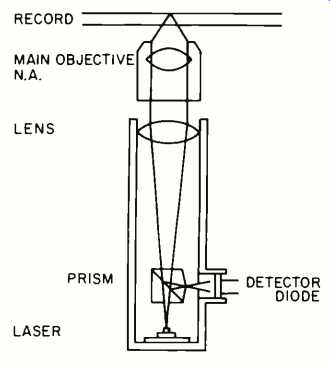
Fig. 8--Cross-section of the laser element and disc surface of Philips Compact
Disc system. The Sony laser element is fairly similar.
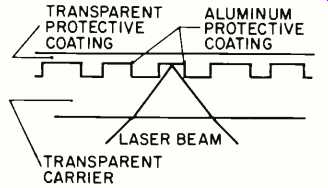
Fig. 9--Cross-section of Philips compact-disc, showing pits and transparent
surface layer. Sony's disc is similar.
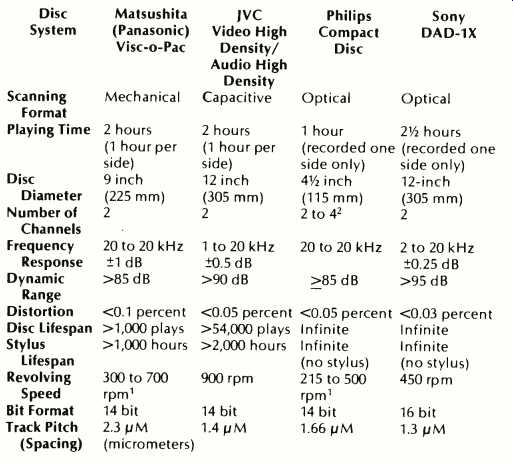
Table 1--Comparative Specifications of Four Prototype Digital Audio
Disc Systems.
Notes: 1. Speed varies dependent upon position of scanning element. 2. Playing time 45 minutes in four-channel mode.
------------
Philips projects a cost for the Compact Disc system "comparable to the cost of a good conventional record player," in their terms, and most ob servers interpret this to mean a price under $500.00 for the player.
Sony's DAD-1X also uses a beam from a low-power laser, focused from beneath on the reflective center layer of a pitted plastic disc. As with the Philips, in the DAD-1X the modulated light reflected from the disc is carried through an arrangement of mirrors and prisms to an optical detector system, which converts the modulations into a PCM-encoded musical signal.
But the disc itself is different. Unlike Philips, Sony may well offer a single player as a combined videodisc and digital audio disc player, and since video recordings require even higher information density than digital audio recordings, the 12-in. disc diameter Sony has adopted provides 2 1/2 hours of playing time on one side of the disc, as against one hour of video playing time. Intriguingly, Sony says that it is technically feasible to encode both sides of their disc, which would yield a total of five hours of playing time from a single double-sided disc! A reference signal is recorded between selections on the Sony disc, and the player has the capacity to automatically locate a particular program. As with the Philips (and all other optical systems demonstrated thus far), the DAD-1X's laser element and disc surface are non-contacting and therefore not subject to wear.
Sony has announced no projected price for their player or discs, and no target introduction date. They describe the unit as a prototype, demonstrated primarily to solicit commentary on the optimal design for final production.
The Compatibility Question
The manufacturers of most systems demonstrated (which also include Pioneer and Mitsubishi with optical disc systems and RCA with a possible capacitive system) make at least a pretense of saying that they will market a proprietary system in the early '80s.
Most everyone agrees, though, that the simultaneous introduction of several incompatible digital disc systems, each in limited quantity and with a limited software catalog, would probably result in a marketing catastrophe at least on the scale of the quadraphonic disaster of the early 70s. The Japanese government has requested that a common standard be set for digital audio discs, and about 30 manufacturers have taken part in standards commit tee meetings seeking to compromise on a single disc system. No one in Japan or outside of it is legally bound to a doctrine of one unified system, but most observers feel that some degree of consensus will be reached, at least among the Japanese manufacturers, in the next few years.
The whole story of the corporate politics surrounding the videodisc and digital audio disc standards questions is an extremely involved one, both volatile and complex. The important point to bear in mind is that the products we have examined are all in the prototype stage, and most likely substantial changes will take place, in many cases before they reach the market. It is possible that some of the companies in question will abandon one technical format in favor of another, so as to share the costs of software development and licensing with other companies, acquire greater marketing strength through alliance, and thereby improve the chances of a given system being accepted by the public. Probably more than one system will reach the market; whether two or more can coexist is another question. Unlike the LP versus 45 struggle of the '50s, no armistice-style compromise wherein a single player can be used with two different disc formats seems likely or even practical.
It is also not likely that you will throw away your record collection and turntable on the same day you buy your digital disc player. It will take many years for the catalog of available digital programs to near the size of the immense analog library we now enjoy.
Philips, for instance, forecasts a 10-year period of parallel use of analog and digital systems. The quaint, fussy device we call the phonograph will be around for quite a while. But even though its period will not soon end, the era of the digital disc will soon begin.
(adapted from Audio magazine, Dec. 1979)
Also see:
Digital Techniques in Sound Reproduction-- Part I (April 1980)
Telefunken Digital Mini Disc (June 1981)
= = = =